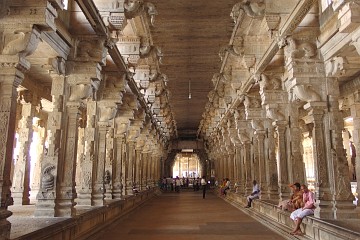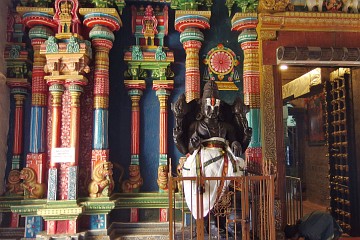Temples Inside Out
(vero;2015-May-17)
Tamil Nadu is the place of choice to explore southern Indian temple culture and architecture.
The temples there teem with devotees and pilgrims, and are ideal to witness Hindu rituals at their best, from the daily puja to weddings, not to mention the many festivals and processions you are bound to come across. Tamil Nadu temples are also rightly famous for their size and their impressive architecture: soaring bright coloured gopurams, finely carved interiors, pools, yards dotted with shrines, statues of deities brightly decorated, it is a feast for the eyes.
In fact, there are so many temples around that it is difficult to chose which one to visit. At the beginning, we trusted our guidebooks and tended to stick to the BIG ones: Sri Meenakshi in Madurai, Arunachaleswar in Tiruvannamalai, Sri Ranganathaswamy in Trichy, Nataraja in Chidambaram.
However, we soon found out that although being of truly magnificent architecture, those temples were enormously frustrating to visit (with the exception of the Arunachaleswar temple in Tiruvannamalai).
 This was particularly true for all active temples: as non-Hindu, one is generally not allowed into the inner sanctum, and some of them have come to forbid access even to secondary shrines, making large areas out of bound and a joke of any visit. In others, the Brahmin priests in charge of the temple management are so unfriendly and aggressive (to us foreigners, but also to Indian devotees) that the whole experience can get quite unpleasant and unnerving.
This was particularly true for all active temples: as non-Hindu, one is generally not allowed into the inner sanctum, and some of them have come to forbid access even to secondary shrines, making large areas out of bound and a joke of any visit. In others, the Brahmin priests in charge of the temple management are so unfriendly and aggressive (to us foreigners, but also to Indian devotees) that the whole experience can get quite unpleasant and unnerving.
So we learnt to be more discerning and started giving more attention to ancient (less active) temples (like Gangaikondacholapuram or Thanjavur) or smaller temples where the overall atmosphere is much more relaxed and welcoming (we could even access the inner sanctum in some of them). We also found out that the architecture of many smaller temples, not even mentioned in the guidebooks and discovered while ambling through a neighbourhood, was as impressive as in the big temples. We had a great time in exploring those: our personal highlight in this respect was the town of Kumbakonam.
A nice thing in Tamil Nadu temples is that nearly all of them have a resident elephant on their premises: among other things like parading, his job is to give blessings to pilgrims and visitors. Vero could not resist and had to take the chance: after you have deposited a rupee on his trunk, the elephant then touches softly your head to bless you. He will do so for several pilgrims, collecting all coins in his trunk, and at some point will give them to his mahout sitting behind him on the floor.
You can find descriptions of some of the temples we visited as well as our (very suggestive of course) experience on the ground in the emails we sent while on the road:
- Madurai and Trichy: Mail from 02 Apr 2015
- Kumbakonam, Chidambaram: Mail from 11 Apr 2015
- Tiruvannamalai: Mail from 03 May 2015
We also have a page with photos from street processions, a recurring cheerful and colourful feature of southern Indian cities.
Want to read more? Go back to Kerala or God's Own Country or go on to A Visit to Chennai's High Court or go up to Blog
$ updated from: Blog.htxt Mon 28 Apr 2025 14:55:29 trvl2 — Copyright © 2025 Vero and Thomas Lauer unless otherwise stated | All rights reserved $




